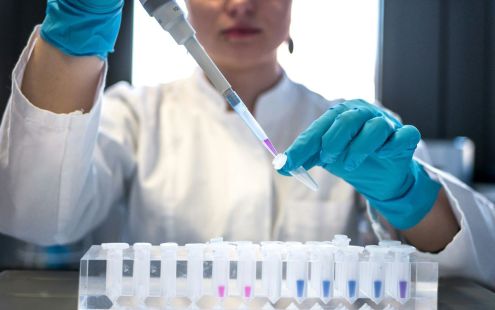Characterization and Biological Potential of the Humanin Peptide

Sponsored article
Studies suggest that the Micropeptide Humanin (HN) is encoded in mitochondrial DNA and may have cytoprotective characteristics that prevent cells, particularly neurons, from undergoing apoptosis, also known as programmed cell death. Some research suggests the Humanin Peptide may therefore have applications in cardiovascular disease and Alzheimer’s disease.
Cell ageing, Alzheimer’s disease, blindness, insulin resistance, diabetes, mitochondrial dysfunction, and vascular dysfunction are all associated with lower endogenous Humanin levels. Elevated levels in mice may also signal the presence of preeclampsia or certain malignancies.
Research indicates that through its possible impacts on cell death regulation, insulin sensitivity, inflammation, and atherosclerotic plaque degradation, Humanin may potentially increase cell lifespan. It has been hypothesized to protect neurons from damage by blocking the apoptotic process and reducing the buildup of beta-amyloid plaque.
Regarding insulin resistance, HN is believed to be relevant also in research within the context of obesity, by potentially restoring normal blood sugar levels by preventing the death of pancreatic beta cells and improving glucose tolerance. Additionally, it has been theorized to protect blood arteries from harmful cholesterol and lower oxidative stress, which is believed influential in heart function.
Humanin is thought to lessen the rate of substantial bone remodeling and loss and stop the death of chondrocytes, the cells keeping bones strong. Retinal pigment epithelium protection against age-related macular degeneration is one of its hypothesized impacts on eyes and ocular nerves.
Investigations purport that the potential additional properties might include be a defense against UV radiation, enhancement of short-term memory recall, mitigation of pathologies associated with Huntington’s disease, aid with amyotrophic lateral sclerosis, and induce of weight loss. A complete understanding of all possible impacts requires more investigation.
Humanin Peptide: Overview
Research has indicated that Humanin (HN), a polypeptide and a micro-peptide that occurs naturally, may inhibit the death of neurons caused by many Alzheimer’s disease genes. Humanin is encoded in mitochondrial DNA as a cytoprotective protein, preventing cell death. Programmed cell death is known as apoptosis. Tests documented that it might protect neurons, muscle cells, heart tissue, and the eye’s retina by preventing cells from this potentially fatal process.
Humanin peptide has suggested promise in mitigating the onset of cardiovascular disease and Alzheimer’s disease, according to animal model and cell culture research.
What is it?
Short, open reading frames are used to make Humanin. Once formed, it does not change since it is a micro-peptide.
Humanin is one of the tiniest micropeptides explored in scientific research, with a length of only 24 amino acids. Its primary characteristic is its potential to control cell death by interacting with the Bax protein and removing its activity when cell survival is in danger.
Studies have suggested that male mice usually have lower HN levels than female mice. A balanced Humanin level may be critical to maintaining optimal organism function. Several physiological issues might arise from either too low or too high levels.
When Humanin levels are low, it might be a sign of:
- Alzheimer’s disease
- Loss of vision
- Resistance to insulin
- Diabetes I
- Problems with mitochondria
- Problems with blood vessels malfunctioning
Excessive Humanin levels may be a sign of or cause:
- Some malignancies
- Gestation
Humanin Peptide’s Biological Potential in Research
Investigations purport that Humanin peptide may have many properties that have been suggested in experimental studies. Studies have speculated the following impacts of this peptide, notwithstanding the scant data on Humanin properties.
Increasing Cell Lifespan
Research has indicated that levels of HN peptide may be adversely affected by growth hormone (GH). For example, studies have indicated that levels of HN appeared greater and survival rates were longer in mice that could not generate enough growth hormone (GH).
HN has been hypothesized to dissolve atherosclerotic plaques, reduce inflammation, improve insulin sensitivity, and decrease cell death. Recent experiments have indicated that the Humanin peptide may increase cell lifespan, which supports this hypothesis.
Brain Health
According to rat research, Humanin seems to protect against programmed cell death in some contexts. In Alzheimer’s disease, for instance, the peptide is theorized to shield neurons from cell death brought on by the accumulation of beta-amyloid plaque. In addition, studies using NMDA pulses have purported that Humanin might protect neurons from excitotoxic damage.
Humanin has been speculated to protect neurons via two distinct pathways. Mitochondria are unable to trigger cell death due to these two processes. Humanin is believed to inhibit apoptosis by attaching to and preventing the activity of the Bcl-2 boosting proteins tBid and Bid.
A recent study out of Argentina suggested that astrocytes secrete Humanin to protect synapses in hippocampus neurons. According to the research, supplementing with Humanin seems to help older animals stave against age-related losses, including memory loss.
Insulin Resistance
Studies in animals have suggested that HN may improve glucose tolerance and prevent the loss of pancreatic beta cells. Accordingly, Humanin may also have concrete impacts in the context of type 1 and type 2 diabetes.
Furthermore, research indicated that Humanin may have balanced blood glucose levels by acting on the hypothalamus, increasing insulin sensitivity in the liver.
Consequently, new research indicates that Humanin may aid in the context of obesity by reducing the likelihood of weight gain by increasing insulin release in response to glucose stimulation.
Heart Health
Investigations purport that Humanin peptide may aid in protecting blood arteries against oxidized LDL cholesterol, a byproduct of bad cholesterol. Additionally, it has been hypothesized that species in the vasculature may be reduced by 50% via interacting with the production of free radicals in response to LDL oxidation. Curiously, it also seems to reduce cell death by half.
Another way Humanin is thought to protect the organism from left coronary occlusion damage is by lowering oxidative stress and increasing AMPK and eNOS.
Researchers have speculated two main ways Humanin may be pivotal for bone density and development. The first way is to stop chondrocytes, the cells in charge of bone strength, from dying. Concurrently, Humanin has been hypothesized to decrease osteoclast production while increasing chondrocyte growth. The cells responsible for reshaping and breaking down bone are known as osteoclasts. Studies have implied that Humanin peptide may significantly decrease bone remodeling and loss by inhibiting this development.
References:
[i] Lei H, Rao M. The role of humanin in the regulation of reproduction. Biochim Biophys Acta Gen Subj. 2022 Jan;1866(1):130023. doi: 10.1016/j.bbagen.2021.130023. Epub 2021 Oct 7. PMID: 34626748.
[ii] Coradduzza D, Congiargiu A, Chen Z, Cruciani S, Zinellu A, Carru C, Medici S. Humanin and Its Pathophysiological Roles in Aging: A Systematic Review. Biology (Basel). 2023 Apr 6;12(4):558. doi: 10.3390/biology12040558. PMID: 37106758; PMCID: PMC10135985.
[iii] Niikura T. Humanin and Alzheimer’s disease: The beginning of a new field. Biochim Biophys Acta Gen Subj. 2022 Jan;1866(1):130024. doi: 10.1016/j.bbagen.2021.130024. Epub 2021 Oct 7. PMID: 34626746.
[iv] Xiao J, Kim SJ, Cohen P, Yen K. Humanin: Functional Interfaces with IGF-I. Growth Horm IGF Res. 2016 Aug;29:21-27. doi: 10.1016/j.ghir.2016.03.005. Epub 2016 Apr 7. PMID: 27082450; PMCID: PMC4961574.
[v] Hazafa A, Batool A, Ahmad S, Amjad M, Chaudhry SN, Asad J, Ghuman HF, Khan HM, Naeem M, Ghani U. Humanin: A mitochondrial-derived peptide in the treatment of apoptosis-related diseases. Life Sci. 2021 Jan 1;264:118679. doi: 10.1016/j.lfs.2020.118679. Epub 2020 Oct 29. PMID: 33130077.








